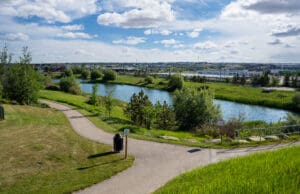Wetlands are unique ecosystems that play a vital role in maintaining water quality, supporting wildlife habitats, and mitigating the impacts of floods and droughts. A wetland designation in Oregon has significant implications for land planning and development. We’ve compiled information about wetlands, including the criteria for their designation, the process of gaining approval for development on properties with designated wetlands, and the reasons behind Oregon’s commitment to wetland conservation.
 The Importance of Wetland Designations in Oregon
The Importance of Wetland Designations in Oregon
Oregon’s commitment to wetland designations stems from recognizing the significant ecological functions and benefits that wetlands provide. Although wetlands cover only about 2 percent of the state’s land base, they offer numerous ecosystem services and support a diverse range of species. The state’s wetland designations serve several purposes:
- Environmental Protection: Wetlands help maintain water quality, regulate water flow, and provide critical habitat for wildlife. Designations ensure the preservation and restoration of these valuable ecosystems.
- Flood and Drought Mitigation: Wetlands act as natural buffers against floods by absorbing and storing excess water. During droughts, they release stored water, helping to maintain water availability.
- Biodiversity Conservation: Wetlands support various plant and animal species, including rare and endangered ones. Designations protect these habitats and contribute to the preservation of biodiversity.
- Sustainable Land Use: By incorporating wetland protection into land use planning and zoning regulations, Oregon aims to achieve sustainable development that balances economic growth with environmental conservation.
What Defines a Wetland Designation in Oregon?
A wetland is an area of land characterized by the presence of water, either permanently or seasonally, and specific types of vegetation and soil conditions. The Oregon Department of State Lands (DSL) and the Department of Land Conservation and Development (DLCD) determine the criteria for designating an area as a wetland in Oregon. These criteria include:
- Hydrology: Wetlands are defined by the presence of water, evident through the presence of saturated or inundated soils, surface water, or shallow groundwater.
- Vegetation: Wetlands are home to unique plant species adapted to wet conditions. Hydrophytic vegetation, such as cattails, sedges, and willows, is an essential indicator of wetland status.
- Soils: Wetland soils exhibit specific characteristics, such as poor drainage, organic content, and distinct soil colors, indicative of wetland conditions.
- Wetland Functions: Wetlands provide various ecosystem services, including water filtration, flood control, and habitat provision. The functions and values of wetlands vary across regions and landscapes.
Wetland Designations and Zoning Classifications
Wetland designations directly impact zoning classifications and land use in Oregon. The state has established regulations and planning frameworks to protect and manage wetlands effectively. Here’s how wetland designations in Oregon influence land use:
- Land Use Planning Goals: Oregon’s DLCD administers statewide planning goals, including Goal 5, which requires local protection of significant wetlands. Local governments are responsible for incorporating wetland protection into their land use planning and zoning regulations.
- Approval Process: If a property has a designated wetland, landowners must go through an approval process to develop the land. An approved wetland conservation plan is required, and notice of activities authorized within the plan must be provided to the DSL within five days following local approval.
- Regulations: Wetlands in Oregon are regulated through federal and state laws and city or county ordinances. These regulations ensure that wetlands are protected and managed appropriately during land development.
Navigating the Approval Process in Oregon
For landowners in Oregon seeking to develop a property with a designated wetland, it is essential to follow the proper approval process. Here are the key steps involved:
- Consult Local Authorities: Consult with local authorities, such as the DSL and DLCD, to understand the specific wetland designations and regulations that apply to the property. They can provide guidance on the approval process and the necessary documentation.
- Develop a Wetland Conservation Plan: A wetland conservation plan outlines how the proposed development will avoid or minimize impacts on the wetland. It should include measures to mitigate any unavoidable effects. The DSL must approve the plan and comply with state and local regulations.
- Submit the Plan for Approval: Once the wetland conservation plan is developed, it must be submitted to the DSL for review and approval. The DSL will assess the plan’s compliance with wetland protection regulations and its potential impacts on the wetland ecosystem.
- Obtain Local Approval: After receiving approval from the DSL, the landowner must seek local approval from the relevant city or county authorities. This step ensures compliance with local zoning regulations and land use planning goals.
- Implement the Approved Plan: Once all necessary approvals are obtained, the landowner can proceed with the development, following the guidelines and conditions outlined in the approved wetland conservation plan.
Choose Richard Stevens & Associates for all your land planning needs.
Property with a wetland designation in Oregon may significantly impact your land planning and development needs. Understanding the criteria for wetland designation, the approval process for developing properties with designated wetlands, and the importance of wetland conservation helps landowners navigate the regulatory landscape and contribute to the preservation of these valuable ecosystems. Our Richard Stevens & Associates team can help you navigate all the steps necessary to investigate property designations and required procedures to obtain development approvals. By protecting and managing wetlands, Oregon aims to achieve a sustainable balance between development and environmental conservation.

 The Importance of Wetland Designations in Oregon
The Importance of Wetland Designations in Oregon